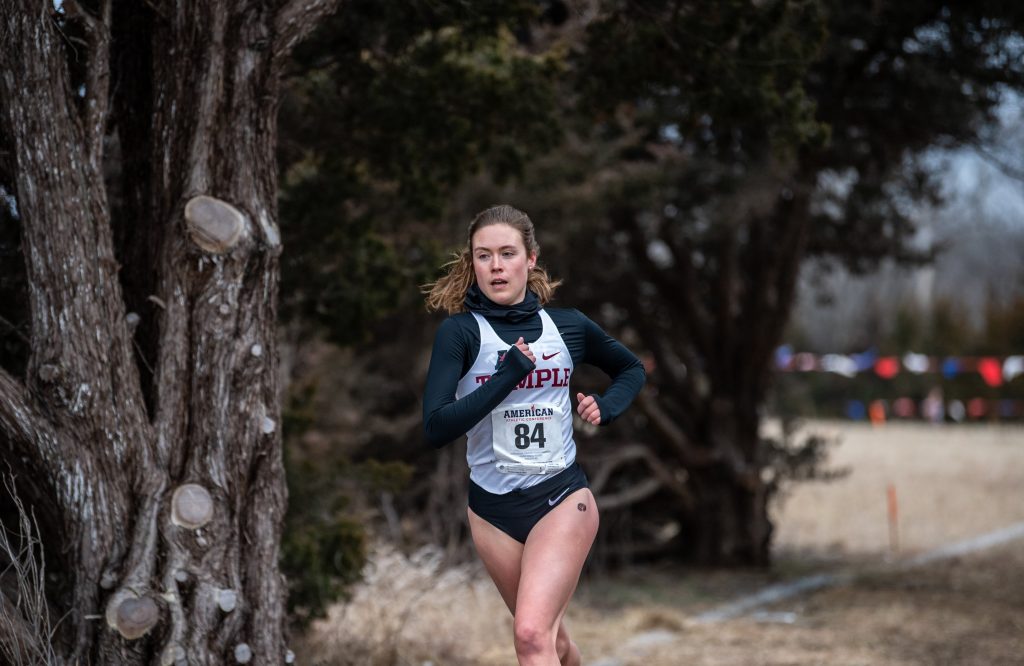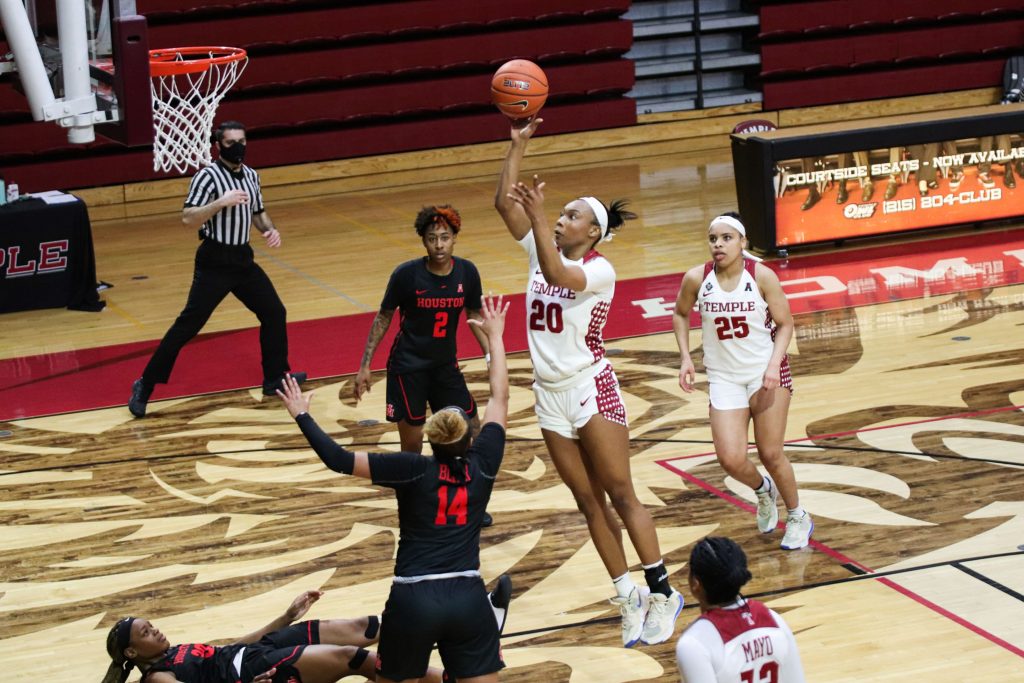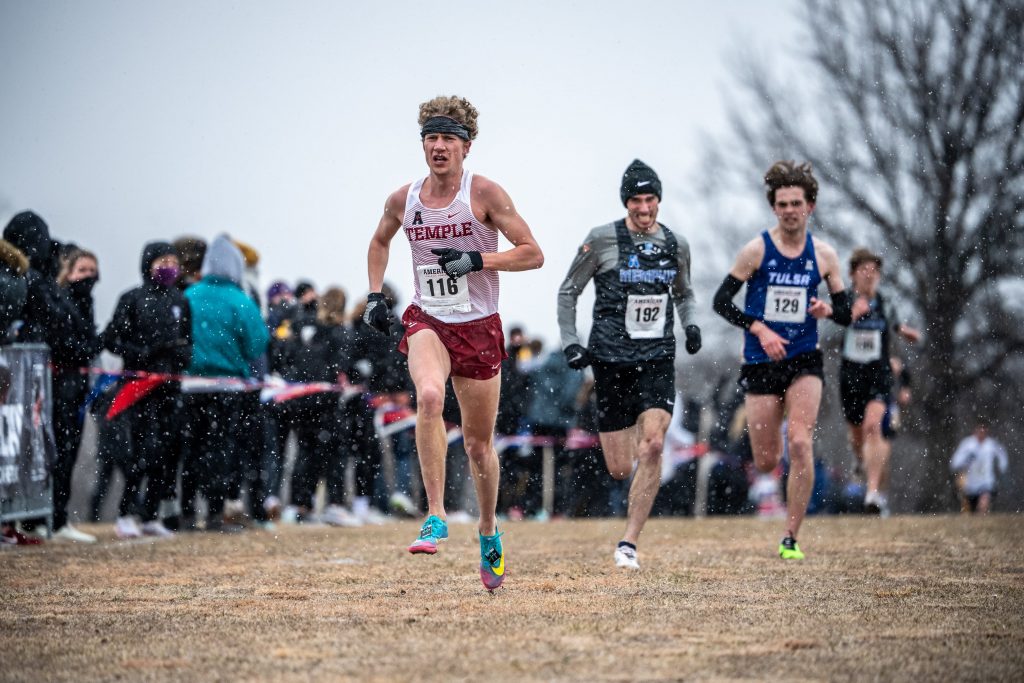Before returning to Temple University for the Fall 2020 semester, Brandon Johnson spent his summer months alongside teammates training and trying to remain optimistic about the coming season, which would be his last as a Temple student-athlete.
“We went on a lot of runs, found random fields to play on, and if we got kicked off, we hopped fences and found other places to train,” said Johnson, a redshirt-senior defender on Temple men’s soccer team. “But in the back of a lot of players’ minds, we knew it wasn’t going to be certain we would have a season.”
On Aug. 25, 2020, Johnson’s concerns were realized when The American Athletic Conference announced the postponement of men’s soccer start until Spring 2021.
Postponed seasons, crowdless games and an increase in COVID-19 tests are just a few of the new realities student-athletes like Johnson have adapted to as Temple’s fall, winter and spring sports teams struggle to maintain some sense of a normal season of competition amid the ongoing pandemic.
With the long list of challenges this year has brought, here’s how eight student-athletes navigated their seasons of uncertainty.
PANDEMIC LOGISTICS

The continuation of Temple Athletics has been contingent on a strict set of safety procedures intended to mitigate the potential spread of COVID-19 during the 2020-21 academic year. This represents a unique challenge due to the frequent close-contact interactions between student-athletes and athletic staff on a daily basis.
A major logistical hurdle during the 2020-21 season is implementing COVID-19 testing programs and social distancing protocols in athletic facilities across campus.
In the fall semester, student-athletes would receive testing every Monday prior to practice starting, said Kevin Addison, associate director of athletic training, on Jan. 11.
With 12 in-season sports competing this spring, Temple Athletics increased the amount of times student-athletes are tested for all sports compared to this past fall, while only six sports were being managed.
“It felt like every time we were getting it going or we’re getting into a groove and we would start to really know one another, we would get shut down for a week or two.”
Men’s basketball freshman guard Jeremiah Williams
Student-athletes in intermediate risk sports, which the NCAA categorizes by level of contact while competing, like soccer, field hockey, lacrosse and rowing, must receive one polymerase chain reaction test per week by the university. Student-athletes in low-risk sports, like cross country, gymnastics, tennis and track and field, must receive one PCR test 72 hours before competition, The Temple News reported.
Temple Athletics designated both basketball and volleyball as high-risk sports due to the close proximity between student-athletes in practice and competitive settings. Student-athletes from these teams are required to obtain two PCR tests and an antigen test every week, The Temple News reported.
The men’s basketball program postponed eight games so far this season due to COVID-19 protocol issues.
“It felt like every time we were getting it going or we’re getting into a groove and we would start to really know one another, we would get shut down for a week or two,” said men’s basketball freshman guard Jeremiah Williams.
Despite constant schedule changes, alterations to the layout of practice was another adjustment the men’s basketball program had to adapt to, which made it difficult when trying to build relationships with different teammates, he added.
During a normal season, the Owls would all work out together on the court or in the weight room, but this season the team splits up into groups to create a smaller and distanced practice, Williams said.

“It might be me, De’Vondre Perry and Quincy Ademokoya one day, and maybe the next day it would be me, Damian Dunn and Jake Forrester in a group,” Williams said. “Coach would try to mix up the groups to mesh different personalities.”
For the women’s basketball team, the women are socially distant at their practices and wear masks at all times off the court, said Temple women’s basketball junior forward Alexa Williamson.
Williamson saw in the fall how the lack of practice time affected the Owls’ physical shape compared to past seasons.
“If we got to be there in the summer for training, and didn’t keep getting postponements, our fitness level would be different since we would have had more time in the facilities,” Williamson said.
In the fall, because student-athletes were unable to use the weight room, training room and locker room facilities, Temple Athletics created a makeshift weight room outside in tents on Temple Sports Complex. This spring, the athletic department is allowing student-athletes to use the facilities, but there are restrictions and guidelines in place, like capacity limits and mask requirements, Addison said on Jan. 11.
Student-athletes must sign up for a time slot on Canvas to visit a trainer, while in previous seasons they were able to walk in at any time, said Temple women’s soccer senior midfielder Julia Dolan.
Intermediate risk sports are not required to wear a mask when practicing or competing, but it’s encouraged when in close contact with others, according to the NCAA’s COVID-19 protocol.
“We put our masks on when we are collected together as a group, but when we get out on the field to train, we pull them down,” Johnson said. “For me, that wasn’t too invasive to have on my neck.”
Inside the weight room, everyone wears a mask and student-athletes have to stay in one spot and go through a rotation, said Temple field hockey sophomore back Emma Nesbitt.
“Only 10 girls are allowed in the locker at a time, which is interesting cause usually we would spend that time as a team in the locker room getting everyone pumped up,” Nesbitt added. “Those were minor difficulties that really stuck out to me and made things difficult at times.”
A MENTAL ADJUSTMENT

Amid the complete absence of competition for many Temple Athletics teams during the last 12 months, adjustments to the day-to-day student-athlete experience are not only physical but also social and mental.
In a distanced practice environment, team leaders like Nesbitt have struggled to keep their team motivated amid uncertainty about whether they’ll be able to compete.
“This fall, we had a practice schedule of 20 hours set aside a week, which is usually only in season when competing,” Nesbitt said. “So to have such intense practices and the end goal was February, looking for those games that were just so far out was a challenge.”
Maintaining a strong sense of camaraderie among teammates while working toward their own goals for the season has been a challenge for team leaders like Temple men’s soccer senior defender Pierre Cayet.
“We kept adapting and tried to make the best out of it, whether it was doing individual workouts or finding a different field, as a senior I did my best to help my coaches and take on some leadership for this team,” Cayet said.
“When you go into quarantine, you never know when your next game is going to be or when you’re going to play again.”
Women’s basketball junior forward Alexa Williamson
Ongoing interruptions to competition schedules, and fewer opportunities to interact with fellow teammates outside of practice strained the bonds typically made between freshmen student-athletes and upperclassmen.
“Freshmen couldn’t hang out or meet others besides their teammates, who were already best friends with each other,” Nesbitt said. “The seniors understood that and made it their goal to have everyone feel welcomed.”
The pandemic also affected student-athletes’ relationships outside of athletics.
Fear of potentially exposing fellow teammates to COVID-19 kept many student-athletes from returning home to see family and friends, including Nesbitt, who has limited her travel to and from her home in Baltimore, Maryland.
“Being a devoted student-athlete is all about committing time to one’s individual program, but making those small sacrifices, like not seeing family or friends in their free time, is a price student-athletes have to pay to practice and compete,” Nesbitt said.
Student-athletes’ rigorous training schedules paired with the everyday uncertainty of the pandemic and its potential impact on competition has been a difficult adjustment for many athletes, including Williamson.
“When you go into quarantine, you never know when your next game is going to be or when you’re going to play again,” Williamson said. “It’s hard, but the people I’m close to, that I couldn’t be around or see, I would just make sure I talk to them over the phone or FaceTime.”
The fact that no matter how safe the team is, there is always a chance that someone may test positive has been a challenging reality to accept, said Temple women’s cross country senior Michelle Joyce.
“We come to practice every day like it’s our last,” Nesbitt said.
POSITIVE TAKEAWAYS

Student-athletes have tried to stay positive about the future and learn to appreciate being able to compete.
The men’s cross country team encountered difficulties early on in the fall during their trail runs in various parts of the city because they were heckled by Philadelphia residents for not wearing masks, said Temple men’s cross country senior Kristian Jensen.
“Both the administration and coaches got emails saying they weren’t happy with us running around the city, so we actually decided to leave Philly and go to Montana for training camp for two months in the fall,” Jensen said.
With the help of parents, the men’s cross country team packed up and traveled to a cabin owned by the family of a fellow teammate in Red Lodge, Montana, where they spent the last two months training for the spring season.
“It was a last minute decision, but we were in a beautiful area with high altitude and great training,” Jensen said. “While living together, we would cook burgers every Sunday night and be able to get away from the craziness for two months.”
It was an experience of a lifetime for this group to all live together, Jensen added.
Temple’s coaching staff in each athletic program has tried different ways to keep everyone motivated during the offseason.

“We met every week with a sports psychologist, we talked about a lot of things, like remaining positive,” Nesbitt said. “We could have let a lot of things bump us down, but that’s not the route we are going to take and worked around it.”
The field hockey team brought a portable music speaker onto the field during practice as a way to turn the negative of not being allowed in the locker room getting pumped together to a positive, Nesbitt added.
More in-person practice time was a way of escape for student-athletes, who were taking online classes.
Nesbitt realized she’s grateful to be able to have field hockey practice everyday because it’s a way of escape from constantly staring at a computer screen, and gives her a chance to run around and interact with people face-to-face, she said.
For the majority of fall sports, competition began in late January or early February, and it was a surreal moment for student-athletes to finally step on a field to see their hard work pay off.
“I took a second on game day on the field, and I was extremely grateful that we were able to play,” Johnson said. “As a team, I think we were more relieved that we were playing someone besides ourselves for a change.”
Every fall sport besides football practiced with each other for more than a year without competing in games, and it can be tiring to keep going against their own teammates, Johnson added.
“I cried a little bit on the cool down after our first match of the season, I don’t know if that was because it was really cold or if it was all the emotions coming out,” Jensen said. “I kind of fell out of the group for a minute and jogged behind them to take a look at all these young boys, and I’m overall really proud of what we overcame together.”